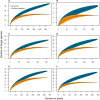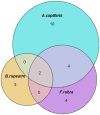Disruption of Traditional Grazing and Fire Regimes Shape the Fungal Endophyte Assemblages of the Tall-Grass Brachypodium rupestre
- PMID: 34177863
- PMCID: PMC8226146
- DOI: 10.3389/fmicb.2021.679729
Disruption of Traditional Grazing and Fire Regimes Shape the Fungal Endophyte Assemblages of the Tall-Grass Brachypodium rupestre
Abstract
The plant microbiome is likely to play a key role in the resilience of communities to the global climate change. This research analyses the culturable fungal mycobiota of Brachypodium rupestre across a sharp gradient of disturbance caused by an intense, anthropogenic fire regime. This factor has dramatic consequences for the community composition and diversity of high-altitude grasslands in the Pyrenees. Plants were sampled at six sites, and the fungal assemblages of shoots, rhizomes, and roots were characterized by culture-dependent techniques. Compared to other co-occurring grasses, B. rupestre hosted a poorer mycobiome which consisted of many rare species and a few core species that differed between aerial and belowground tissues. Recurrent burnings did not affect the diversity of the endophyte assemblages, but the percentages of infection of two core species -Omnidemptus graminis and Lachnum sp. -increased significantly. The patterns observed might be explained by (1) the capacity to survive in belowground tissues during winter and rapidly spread to the shoots when the grass starts its spring growth (O. graminis), and (2) the location in belowground tissues and its resistance to stress (Lachnum sp.). Future work should address whether the enhanced taxa have a role in the expansive success of B. rupestre in these anthropized environments.
Keywords: Brachypodium rupestre; Epichloë typhina; Lachnum sp.; Omnidemptus graminis; culturable endophytes; disturbances; fire recurrence.
Copyright © 2021 Durán, San Emeterio, Múgica, Zabalgogeazcoa, Vázquez de Aldana and Canals.
Conflict of interest statement
The authors declare that the research was conducted in the absence of any commercial or financial relationships that could be construed as a potential conflict of interest.
Figures










Similar articles
-
Comparison of Culturing and Metabarcoding Methods to Describe the Fungal Endophytic Assemblage of Brachypodium rupestre Growing in a Range of Anthropized Disturbance Regimes.Biology (Basel). 2021 Nov 29;10(12):1246. doi: 10.3390/biology10121246. Biology (Basel). 2021. PMID: 34943161 Free PMC article.
-
Decoupling of traditional burnings and grazing regimes alters plant diversity and dominant species competition in high-mountain grasslands.Sci Total Environ. 2021 Oct 10;790:147917. doi: 10.1016/j.scitotenv.2021.147917. Epub 2021 May 23. Sci Total Environ. 2021. PMID: 34107407
-
A Survey of Culturable Fungal Endophytes From Festuca rubra subsp. pruinosa, a Grass From Marine Cliffs, Reveals a Core Microbiome.Front Microbiol. 2019 Jan 16;9:3321. doi: 10.3389/fmicb.2018.03321. eCollection 2018. Front Microbiol. 2019. PMID: 30700985 Free PMC article.
-
Forages and pastures symposium: fungal endophytes of tall fescue and perennial ryegrass: pasture friend or foe?J Anim Sci. 2013 May;91(5):2379-94. doi: 10.2527/jas.2012-5951. Epub 2013 Jan 10. J Anim Sci. 2013. PMID: 23307839 Review.
-
A Systematic Review on the Effects of Epichloë Fungal Endophytes on Drought Tolerance in Cool-Season Grasses.Front Plant Sci. 2021 Mar 24;12:644731. doi: 10.3389/fpls.2021.644731. eCollection 2021. Front Plant Sci. 2021. PMID: 33841472 Free PMC article.
Cited by
-
Litter Decomposition in Pacific Northwest Prairies Depends on Fire, with Differential Responses of Saprotrophic and Pyrophilous Fungi.Microorganisms. 2025 Aug 6;13(8):1834. doi: 10.3390/microorganisms13081834. Microorganisms. 2025. PMID: 40871338 Free PMC article.
-
Comparison of Culturing and Metabarcoding Methods to Describe the Fungal Endophytic Assemblage of Brachypodium rupestre Growing in a Range of Anthropized Disturbance Regimes.Biology (Basel). 2021 Nov 29;10(12):1246. doi: 10.3390/biology10121246. Biology (Basel). 2021. PMID: 34943161 Free PMC article.
References
-
- Aizpuru I., Aseginolaza C., Uribe-Echebarría P. M., Urrutia P., Zorrakin I. (1999). Claves Ilustradas de la Flora del País Vasco y Territorios Limítrofes. Vitoria-Gasteiz: Servicio Central de Publicaciones del Gobierno Vasco.
-
- Anderson P. M. L., Hoffman M. T. (2007). The impacts of sustained heavy grazing on plant diversity and composition in lowland and upland habitats across the Kamiesberg mountain range in the Succulent Karoo, South Africa. J. Arid Environ. 70 686–700. 10.1016/j.jaridenv.2006.05.017 - DOI
-
- Armas-Herrera C. M., Martí C., Badía D., Ortiz-Perpiñá O., Girona-García A., Porta J. (2016). Immediate effects of prescribed burning in the central pyrenees on the amount and stability of topsoil organic matter. CATENA 147 238–244. 10.1016/j.catena.2016.07.016 - DOI
LinkOut - more resources
Full Text Sources

